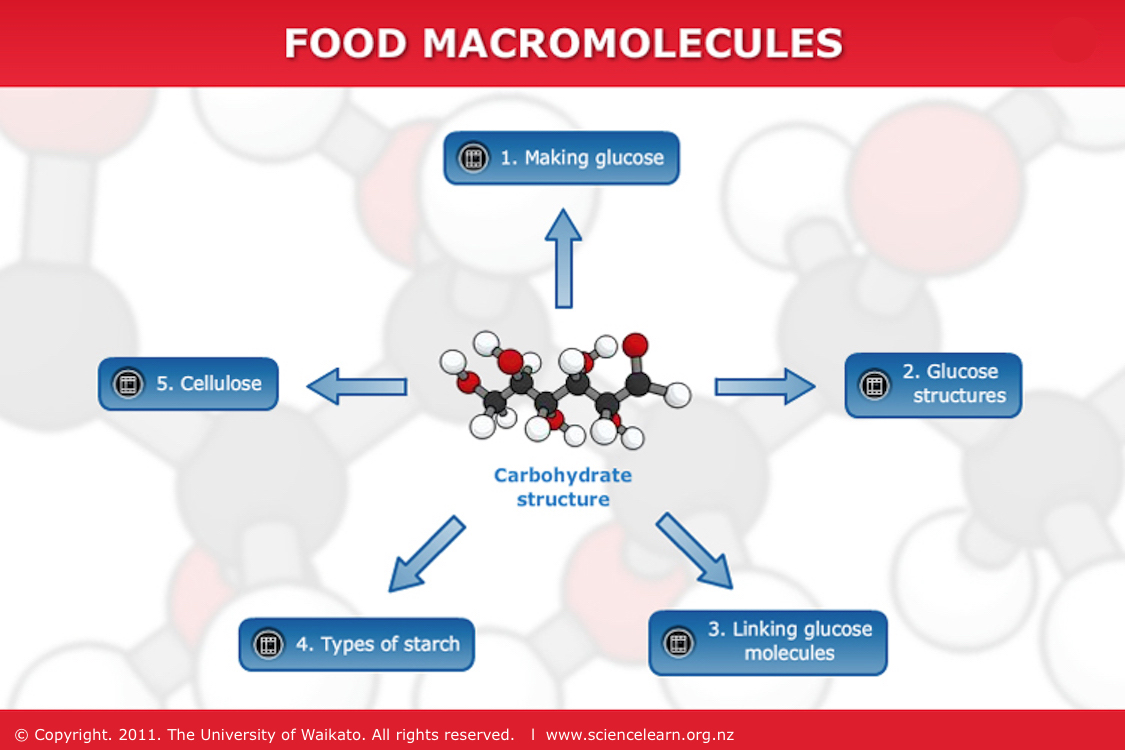The foods we eat supply the energy needed by the body to drive its complex chemical, mechanical and electrical systems. Where does this energy come from, how is it locked into food molecules and how is it released?
Energy from the Sun
The energy content of all food molecules can be traced back to the Sun. It is the process of photosynthesis that locks the Sun’s energy into simple carbohydrates like glucose. Although the photosynthetic process, which is carried out in the chloroplasts present in plant cells, involves numerous steps, it can be summarised in the following equation.
| Energy from sunlight trapped by chlorophyll present in the chloroplasts | + | 6CO2 carbon dioxide | + | 6H2O water | → | C6H12O6 | → | 6O2 oxygen |
This reaction only proceeds with an input of solar energy, and the product glucose stores this energy as chemical potential energy.
Plants are able to convert some of the glucose formed into starch and other macronutrients such as proteins and lipids. The origin of the energy locked into these molecules is from the Sun.
Releasing the locked-up energy
The food we eat supplies the body with energy-rich molecules like glucose. On entering the cells of the body, these molecules are broken down in a series of steps to reform carbon dioxide and water, releasing energy to be used by the body.
Some of the chemical potential energy locked into these molecules is transferred within the cell to a substance called adenosine triphosphate (ATP).
ADP + P + energy → ATP
ATP is often referred to as the energy currency of the cell as it is used to drive the body’s complex chemical, mechanical and electrical systems.
This energy transfer pathway, which occurs within all body cells, is called aerobic respiration, and for carbohydrates like glucose, it is effectively the reverse of photosynthesis.
C6H12O6 + 6O2 → 6CO2 + 6H2O + energy
The amount of energy released for each glucose molecule consumed produces between 36 and 38 ATP molecules.
When the cell needs energy to drive its complex chemical, mechanical and electrical systems, ATP breaks down, releasing the required energy.
ATP → ADP + P + energy
Efficiency of aerobic respiration
Not all of the energy locked into glucose through photosynthesis is released by aerobic respiration. Several different processes are involved, each of which consists of several steps. This results in some of the energy being converted into heat and not ATP.
The energy conversion efficiency for glucose lies between 38–44%, depending on the cell type. In terms of the body as a machine, this compares very well with the 20–25% efficiency of most machines.
Counting the energy of foods
The standard energy unit is the joule. It is defined in the following way: 4.18 joules is the energy needed to heat 1 g of water by 1°C.
The joule is a small unit for everyday purposes, so in food chemistry, the kilojoule is the preferred unit (1000 J = 1 kJ).
The macronutrients in the foods we eat have been analysed for their available energy content when metabolised in the body. The energy values calculated are:
- carbohydrate – 17 kJ/g
- protein – 17 kJ/g
- fat – 37 kJ/g.
If any given meal is carefully analysed for its macronutrient composition, it is possible to calculate the energy input it gives.
Here is an example:
| Main meal items | Portion size (g) | Energy (kJ) | Protein (g) | Fat (g) | CHO (g) |
|---|---|---|---|---|---|
| Roast potato | 200 | 866 | 5.0 | 1.0 | 44.0 |
| Chicken (roast) | 150 | 1010 | 36.9 | 10.4 | 0.0 |
| Asparagus | 80 | 88 | 2.8 | 0.2 | 2.0 |
| Carrot | 50 | 55 | 0.4 | 0.1 | 2.8 |
| Butter chicken sauce | 40 | 240 | 1.0 | 4.0 | 3.9 |
| Ice cream (low fat) | 120 | 706 | 5.8 | 4.0 | 29.6 |
| Peaches (canned) | 120 | 270 | 1.1 | 0.12 | 15.0 |
| Orange juice | 250 | 364 | 1.9 | 0.3 | 21.5 |
| Total | 3,599 |
(Approximate values based on the Concise New Zealand Food Composition Tables 8th edition 2009).
The total daily intake for a moderately active, healthy adult is, on average, about 8,700 kJ. Other meals such as breakfast and lunch along with ‘in between’ snacks supply the rest of the daily energy needed.
Related content
Learn more about the digestion process and its hormonal control in these articles:
Useful link
The Concise New Zealand Food Composition Tables provide up-to-date information from the New Zealand Food Composition Database in PDF and Microsoft Office Excel file format. The Concise Tables contain data on key nutrients for commonly consumed foods and are ideal for quick reference. The latest edition is the 14th from 2021.



